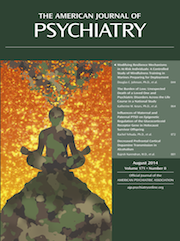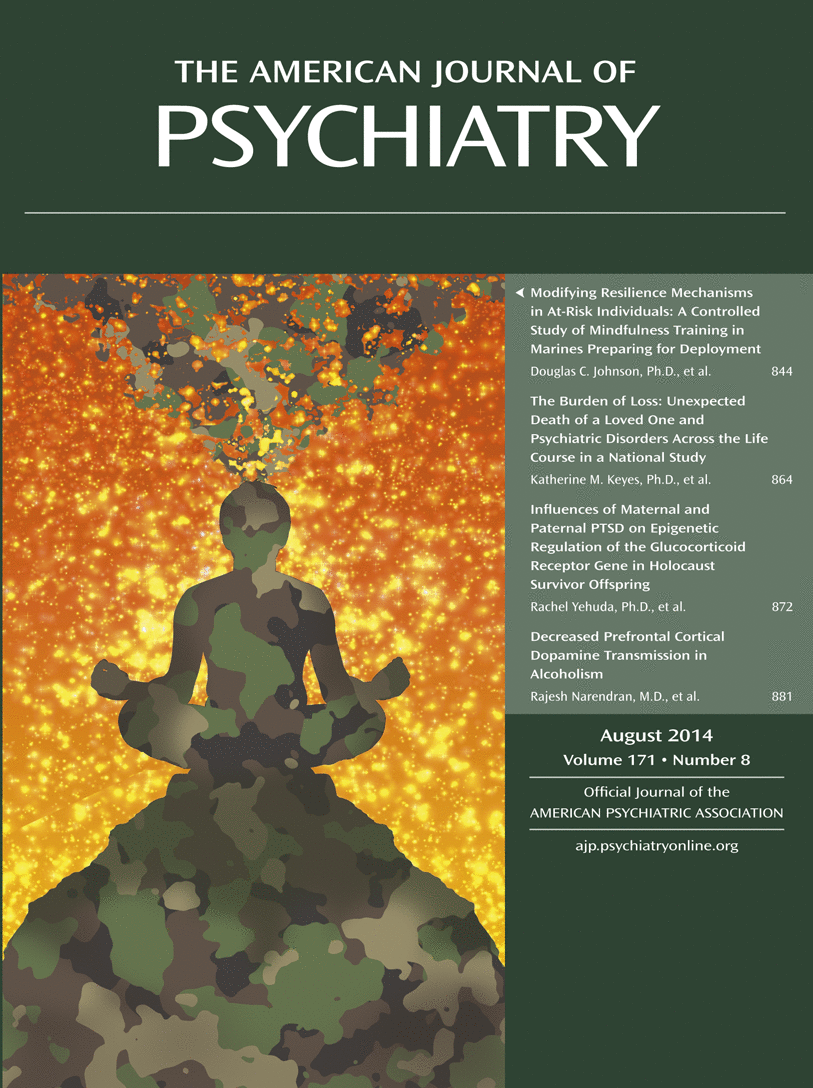Over the past three decades, progress in radiotracer chemistry and instrumentation for positron emission tomography (PET) has enabled us to test mechanistic hypotheses of psychiatric illness generated by integrating clinical observations, animal models, and postmortem data. A major advance in the early 1990s was the development and validation of PET methods to directly measure changes in endogenous dopamine (
1,
2). Initially, serial PET scans with radiotracers for the dopamine (D
2/3) receptor were performed after administration of a placebo or drugs that increased (e.g.,
d-amphetamine, methylphenidate) or decreased (e.g., reserpine, alpha-methyl-para-tyrosine) dopamine concentrations. The majority of studies were performed with the substituted benzamide class of radiotracers: [
11C]raclopride for PET. In fact, raclopride was developed originally as an antipsychotic drug. These antagonist radiotracers bind to the D
2/3 receptor and compete with dopamine so that a pharmacologic increase in endogenous dopamine concentrations would produce a decrease in [
11C]raclopride binding; or vice versa, a decrease in dopamine would increase [
11C]raclopride binding. For the first time, the role of dopamine in many psychiatric and neurological conditions could be evaluated in vivo, and the variability in response could be interpreted in the context of behaviors or symptoms, such as craving, attention, impulsivity, and psychosis, of treatment response, and of genetic polymorphisms related to dopamine neurotransmission (
3–
7). The method was also used to study neurotransmitter interactions in vivo by investigating the effect of drugs that affect serotoninergic, cholinergic, and glutamatergic systems (N-methyl-
d-aspartic acid receptor antagonist, ketamine) on dopamine concentrations (
8,
9). Importantly, the method has been used to study changes in endogenous dopamine during performance of cognitive tasks, induction of behavioral states, or brain stimulation (
10–
12). Dopamine agonist radiotracers that image receptors in the high affinity state have also been evaluated and, as expected, show greater sensitivity to changes in dopamine concentrations than the dopamine antagonist tracers (
13). The applications of these methods seemed endless and the results very intriguing, but we were left with a major limitation: we could only measure changes in the basal ganglia where dopamine D
2/3 receptor concentrations are high. It was not possible to visualize cortical and limbic regions that are involved in cognition and emotion because of the relatively low concentration and relatively rapid radiotracer washout of cortical D
2/3 receptors.
The research conducted by Narendran et al. represents a major advance in the molecular brain imaging field. This research group has published a series of methodologically elegant studies to develop and validate a strategy to measure dopamine concentrations in cortical regions, including the prefrontal cortex, with the high affinity radiotracer [
11C]FLB 457 (
14,
15). This important body of work includes demonstration of low test-retest variability of the method, no artifacts as a result of carryover mass of the radiotracer, no substantial specific binding of the radiotracer in the reference region (the cerebellum), and, importantly, a linear relationship between
d-amphetamine-induced decreases in radiotracer binding and increases in extracellular dopamine as measured by simultaneous PET and in vivo microdialysis in animals. These are all critical steps in developing such a method for subsequent investigation of the in vivo neurochemistry of psychiatric illness. The strategies developed by Narendran et al. represent the most direct and noninvasive method of evaluating cortical dopamine concentrations in the living human brain.
Their study published in this issue of the
Journal (
16) is their first application of the method to patients. They test a fundamental hypothesis of addictive disorders, specifically of alcohol dependence, that prefrontal dopamine concentrations are lower in persons with alcohol dependence than in healthy comparison subjects. Substantial preclinical research has established the important role of dopamine in the prefrontal cortex in working memory, impulsivity, decision making, and other aspects of executive function that are relevant to the core symptoms of addictive disorders, including reinforcement and relapse (
17). A highly selected group of individuals with alcohol dependence who did not have current polysubstance abuse or psychiatric comorbidities and who completed a minimum of 14 days of monitored outpatient abstinence were examined. All participants underwent two PET scans with [
11C]FLB 457 under baseline (first scan) and postamphetamine (second scan) conditions. The primary findings of the study were that baseline cortical D
2/3 binding was not significantly different between the groups. After administration of amphetamine, the healthy comparison group showed a significant reduction in cortical D
2/3 availability, whereas the alcohol-dependent group showed no significant change. The blunted response in individuals with alcohol dependence was observed not only in the prefrontal cortex, as hypothesized, but in other frontal (anterior cingulate, orbitofrontal, and medial frontal), temporal, parietal, and occipital cortical regions. As is the case in many PET studies, because of limitations of the sample size, the associations between the neuroimaging outcomes (blunted cortical dopamine response) and clinical variables (in this case, severity or duration of alcohol dependence) were not significant. Narendran et al. discuss the findings in the context of a neurobiological mechanism underlying cognitive deficits in alcohol dependence and propose a neurobiological model of cortical dopamine hypofunction. An important next step is to replicate the findings in a larger sample and to evaluate the relationship between cortical dopamine function and variables related to alcohol use, craving, abstinence, and executive function. Other important applications of the method would be to study cortical dopamine in individuals “at risk” for alcohol dependence and in individuals with psychiatric comorbidities (e.g., mood disorders) and to apply the method to other drugs of abuse to determine whether the blunted cortical dopamine response is common in all addictive disorders. Another innovative application would be to combine [
11C]FLB 457 imaging with a cognitive or behavioral task to directly test the role of cortical dopamine in the addictive and cognitive aspects of alcohol dependence, such as craving and executive function (
18).
This study truly exemplifies the strengths of PET in identifying unique neurobiological mechanisms for promising intervention targets. This study is the critical first step to identify a new therapeutic target for alcohol dependence. The cortical dopamine deficits are observed in brain regions that comprise neural networks that are likely to be involved in the core symptoms of alcohol dependence, based on animal data. Promising intervention targets that follow from the proposed neurobiological model that directly or indirectly increase cortical dopamine function could be tested. The same PET research strategy employed in this study could be used as a biomarker to identify patients who have a cortical dopamine deficit, to predict treatment response and to assess “target engagement” in order to determine whether the intervention tested is effective in enhancing cortical dopamine function. In summary, the authors have accomplished what we dreamed about almost two decades ago. In a series of important experiments, they have demonstrated the ability to measure dopamine concentrations in the cerebral cortex in the living human brain. This approach will have a profound effect on our ability to test neurobiological hypotheses, as well as to develop and to evaluate novel treatments in a broad range of psychiatric and neurologic conditions for which cortical dopamine function has been implicated.

